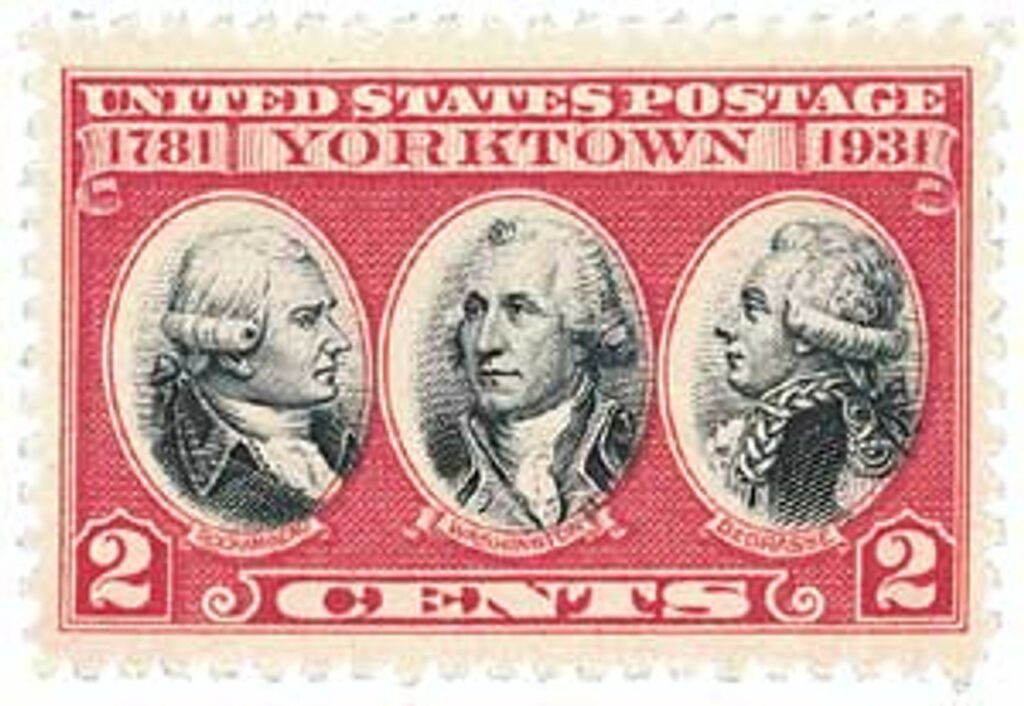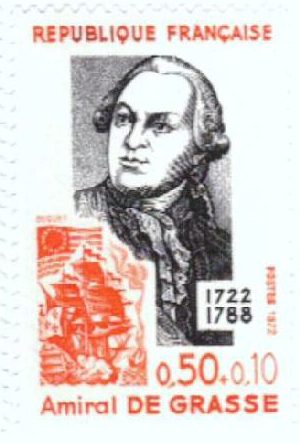On September 5, 1781, French forces won a decisive victory at the Battle of the Virginia Capes. The eventual siege of Yorktown was a success due to the joint efforts of the French fleet and the French and American troops on land.
During the American Revolution, the ability to resupply armies, deploy troops, and transport munitions along Virginia’s inland water routes was dependent on control of the Chesapeake Bay. The Chesapeake Bay is strategically located at the mouth of the James and York Rivers.
In 1779, a British fleet seized control of the Chesapeake Bay, provided additional forces, and destroyed forts and military warehouses along the inland rivers. The raids gave the British necessary supplies, while at the same time depleting the Continental Army’s stockpiles. British expeditionary forces continued the raids throughout 1780 and highlighted Virginia’s military weakness. In the spring of 1781, Major General Marquis de Lafayette entered Virginia and combined his forces with those of General Anthony Wayne. They reached Richmond just in time to prevent the British from burning the capital.
As Lafayette’s forces defended Richmond, British General Lord Charles Cornwallis traveled south along the James River. Joined by other British forces, Cornwallis managed to maneuver around Lafayette’s Continental Army and reach Yorktown on the York River. British naval ships delivered additional troops. On August 2, 1781, Cornwallis began construction of two defensive lines around Yorktown.

Word of Cornwallis’s movements reached General George Washington, who met with French General Rochambeau to determine their next move. Rochambeau convinced Washington to move south and surround the city by land. A fleet under the command of French Admiral de Grasse would secure the Chesapeake Bay and cut off Cornwallis’s escape route on the river.

The French fleet of 27 ships reached Virginia on August 28, 1781, and immediately started a blockade of the York and James Rivers. Additional French troops were delivered to strengthen Lafayette’s forces on land.
At about 9:30 am on September 5, patrol ships from the British and French navies spotted each other’s fleets. The British underestimated the size of their opposition, believing it to be the smaller fleet of Admiral de Barras. Two hours later, the French fleet left the bay and sailed out to meet the British. The battle finally began about 4:00 pm, with the British firing the opening shot. The French used their customary tactic of firing on masts and rigging, to hinder the British mobility.
The fighting continued until sunset. After that, the British commander assessed the situation and concluded that the French hadn’t suffered nearly as much damage as his ships had. De Grasse reached the same conclusion. Originally, the British commander expected to be able to repair his ships and resume the fighting, but the repairs were too significant. As the British fleet drifted eastward, the French turned back to the Chesapeake Bay on September 9. The British fleet then turned north and sailed toward New York.
The Battle of the Virginia Capes left the French Army firmly in control of the Chesapeake Bay and the entrances to the James and York Rivers. As a result, the British garrisons at Yorktown and Gloucester Point were completely isolated from resupplies or reinforcement.

In mid-September, Washington’s troops combined with Lafayette’s for a total of 17,600 soldiers opposite the 8,300 entrenched with General Cornwallis. The Siege of Yorktown began on October 9, 1781, with heavy artillery fire on the British defensive line. After a week of heavy battle, the British attempted to evacuate across the York River. However, the British ships that were to transport them had scattered or sunk in a violent storm. With their escape route cut off and the entrances to the York River and the Chesapeake Bay blocked, Cornwallis surrendered at Yorktown. This ended the last major land battle of the war.
| FREE printable This Day in History album pages Download a PDF of today’s article. Get a binder or other supplies to create your This Day in History album. |
Discover what else happened on This Day in History.









God Bless America
And Thank you France.
Thank you Mystic Stamps for these daily history lessons. We then are reminded that America is strong and must continue this way.
And we are reminded that we need allies.
I really like the the way “This Day in History” goes into the nuts and bolts of the allied strategy leading up to the final battle at Yorktown. The stamps, too, help exceptionally well in helping you to visualize what the essay describes so well.
Love the daily history lesson. Always learn something new.
Love seeing the art work on the first day covers.
A truly great detail-history lesson. Thank you so much, Mystic. By and from your essays, we learn more than we would ever know about the history behind the U..S. stamps produced. So interesting and incredible to get opened up to the details behind the development of our GREAT Nation. Thank you, again !!!
Thanks to France! Our earliest ally, and may we be friends always.
Much of the joy of stamp collecting is the history associated with each commemorative or many of the regular postal issues. I recall learning the succession of the presidents, on the original 1938 Presidential Series, by their associated postage amount, e.g. Lincoln on the 16 cent stamp (Our 16th President)
Thank you France.
Great history lesson on how France greatly helped America finally beat the British, gain our independence from them and end the revolutionary war.
Excellent tribute, don’t particularly like rendition of ships and maps as presented. The cover sheets/envelopes and other associated stamps are also excellent. PO can do it right if it chooses?
Our great nation lmao, not these days…
Regards, Rich
Our nation is greater today than ever before in history – despite the wacko’s on the far right. Our allies have come together in following our lead. The world is in envy of our economy, military, compassion and so many other things.
Realize that the resources that France spent on our behalf directly lead to the French Revolution. Our revolution drained their treasury and left the King few options to deal with a disastrous harvest. The Queen did NOT say let them eat cake. A revolutionary cartoonist make that up to rally the mob.
Let us thank, not just the Continental Army of George Washington, but also the French Army and Navy for freeing us from George III, a man who wanted to be King in America. Alliances win modern wars over single countries. Ask Napoleon and Hitler if you don’t believe it.